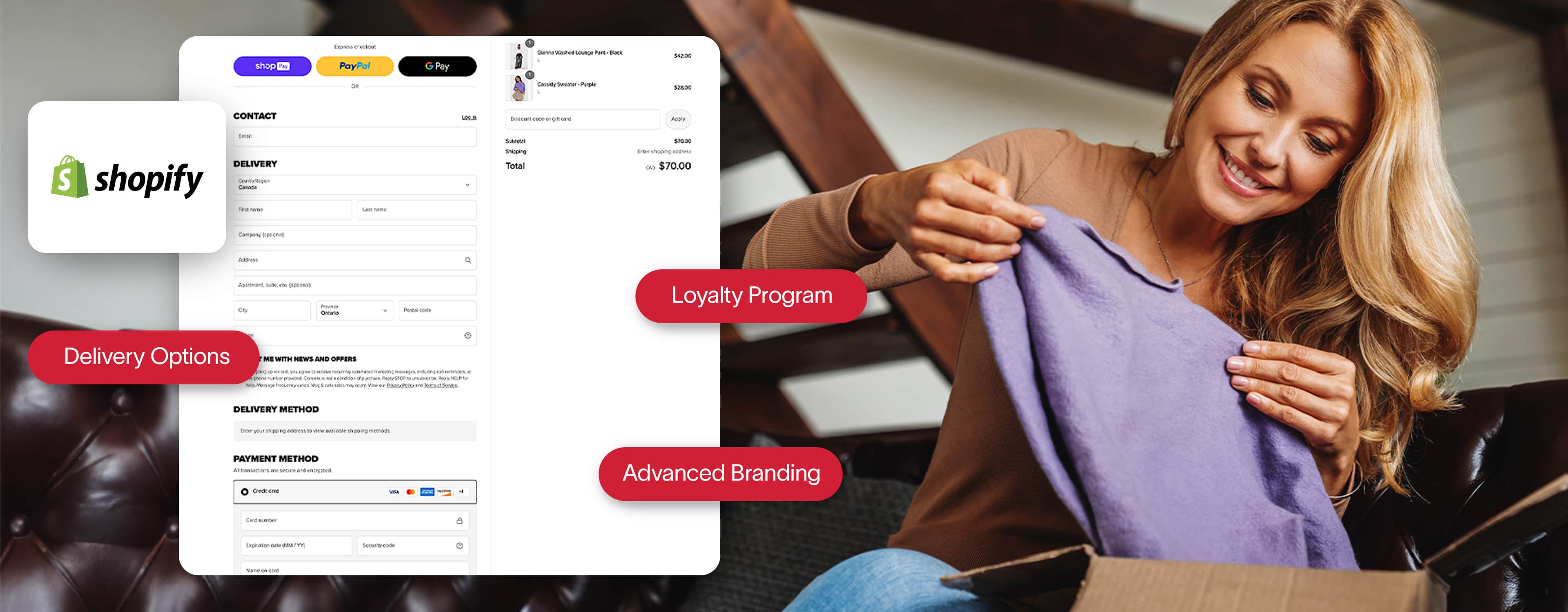How to Prepare for Shopify’s One-Page Checkout Migration
Need to Know
- On August 13, 2024, Shopify will discontinue its legacy checkout functionalities and introduce a new One-Page Checkout using Checkout Extensibility.
- If you are a Shopify Plus merchant using the legacy version of Checkout, you may lose business-critical functionality.
- Make sure your business isn’t disrupted by reviewing this Shopify guide to completing the migration process.
- Contact us using the form at the bottom of this page for expert guidance on how to proceed.
What is happening to Shopify checkout?
On August 13, 2024, Shopify Plus merchants will no longer have the ability to customize the checkout.liquid theme file. Going forward, you will need to make all of your customizations using Checkout Extensibility.
Starting January 6th, 2025, Shopify will begin contacting brands who have not completed the migration to provide notice that stores will be automatically migrated.
What is Shopify’s Checkout Extensibility?
Checkout Extensibility is how Shopify is defining its new approach to the brand’s best-converting checkout in eCommerce.
Simply put, Shopify is changing how they allow Plus merchants to modify their checkout experience. Instead of directly editing checkout code files, merchants can now add customizations using apps specifically designed to extend checkout functionalities.
Functionality isn’t being taken away — instead, Shopify is moving to a more secure and future-compatible approach that still gives merchants the flexibility to make changes based on their needs.
How do I know if I’m impacted by this change?
This upcoming deadline only impacts Shopify Plus merchants. If you are on any other tier of Shopify, you are already using Shopify’s One-Page checkout and no action is required on your part.
If you’re a Shopify Plus merchant, you can determine how this change will impact your store by generating a Checkout Extensibility report from your Admin panel.
How to generate your Checkout Extensibility report:
- From your Shopify admin, go to ‘Settings’ then click ‘Checkout’.
- In the section that says ‘Upgrade to Checkout Extensibility’ click ‘View personalized report.’
This report will summarize the various customizations that have been previously made to your checkout.
Shopify will use AI to provide you with recommendations for 3rd party marketplace apps to replace your custom code files where applicable.
We recommend consulting your internal IT team to ensure you have a proper migration plan in place. And if you’d like some additional guidance, feel free to contact our Northern experts for a free consultation using the form at the bottom of this page.
How do I interpret my Checkout Extensibility report?
In the likely scenario that these checkout customizations continue to support the operations and success of your eCommerce store, you will need to assess your personalized checkout report to determine the appropriate extensible solution.
While your exact customizations will be specific to your industry, products, and business, these are general areas in which we can provide guidance on how to best proceed.
- Styling & Branding
- Frontend Features
- Backend Customizations
- Analytics & Tracking
Styling & Branding
Using the previous version of the checkout, merchants were able to apply their branding through checkout.liquid customizations, providing a more seamless customer experience.
With the upcoming deprecation of the checkout.liquid theme file, brands can now use Shopify’s Checkout Editor or leverage an app using Shopify’s Branding API for additional customizations.
Frontend Features
The checkout.liquid file previously allowed merchants to integrate additional features such as loyalty programs and in-checkout upsells.
These features are still available for merchants but now require you to leverage your partner's app to implement these customizations.
If your store has custom functionality that is not currently achieved through publicly-available apps, you can develop a custom app using Shopify’s APIs.
Backend Customizations
Previously, stores could inject custom functionality into their checkout using Shopify Scripts. This included features such as discounts, payment and delivery customizations, and checkout validations.
Similarly to frontend customizations, merchants can make use of one of the publicly-available apps to implement backend customizations into the new version of checkout. You can also create customizations by developing a custom app using Shopify’s APIs.
Analytics & Tracking
An implication of this migration that is easy to overlook is that with the deprecation of the checkout.liquid file, any custom tracking that has been added to the checkout will need to be migrated.
This would include any Google or Meta Ads, conversion tracking, and any custom Google Tag Manager events. Luckily, Shopify has planned for this with the rollout of its Pixels and customer events feature, which allows merchants to maintain their tracking using a different approach.
Common events and ads tracking are now available using the integrated Sales Channels on Shopify.
For additional tracking, Shopify Apps exist to achieve more tracking use cases. Beyond this, you can directly implement Custom Events, however, this would require technical knowledge of web events and javascript to implement. Shopify has made a helpful video to explain this in further detail.
What do I need to do to migrate?
If Shopify Plus customers choose to take no action before the August 13th deadline, Shopify will lock you out of the checkout.liquid file. This will prevent you from modifying existing customizations, modifying payment methods, impact order fraud assessment, and slowdown Shopify payouts.
You may generate the Checkout Extensibility report and determine that you either have no checkout customizations, or they are no longer relevant to your business, requiring no action on your part.
If you wish to migrate ahead of August 13th, you can preview and launch the new checkout page through your Shopify admin panel.
Summary
While migration may seem daunting, Shopify has made this announcement well in advance of the deadline so many Shopify app and agency partners are well aware of the change and have prepared extensively.
This means that any customizations you may have made over the years have likely already been recreated using a publicly-available app.
If not, Shopify has made its new framework easily extensible with thorough documentation for developers to continue to build onto it, whether through new public apps or custom apps specific to your store and needs.
Want expert help on where to go from here? Contact Northern below.
Learn more about the Shopify Plus Migration
If you’re interested in learning more, Shopify has made a number of resources available that further explain this change and why they’re making it:
Need help? Contact one of our experts.
Stay informed, sign up for our newsletter.

